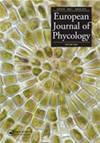浅水临时淡水湖中绿球藻(Chlorococcum,Chlorococtum szentendrense sp.nov)的隐蔽多样性
IF 1.7
4区 生物学
Q2 MARINE & FRESHWATER BIOLOGY
引用次数: 0
摘要
绿球藻属(Chlorococcum)是一个球藻类绿藻属,共有近50种。该属是多系的,但在传统意义上,细胞是球状的,在营养期不活动,具有杯状叶绿体,而孢子具有衣原体的外观。它们主要分布在世界各地的陆地栖息地,并且已经报道了几种菌株的生物技术潜力。在这项研究中,使用显微镜(光镜和透射电子显微镜)和基于DNA的方法(核糖体ITS区、18S核糖体RNA和rbcL基因的系统发育分析以及ITS二级结构比较)对来自匈牙利一个浅层临时淡水湖的三种新的绿藻菌株进行了表征。根据所获得的结果,三个新分离株中的一个被认为代表了一个新物种,该物种在本文中被描述为Chlorococcum szentendrense sp.nov。本文章由计算机程序翻译,如有差异,请以英文原文为准。
Hidden diversity of Chlorococcum (Chlorophyta) in a shallow temporary freshwater lake: description of Chlorococcum szentendrense sp. nov
ABSTRACT Chlorococcum is a coccoid green algal genus, which contains almost 50 species. The genus is polyphyletic, but in a traditional sense, the cells are coccoid and non-motile with a cup-shape chloroplast in the vegetative stage, while the spores have chlamydomonad appearance. They are distributed worldwide mainly in terrestrial habitats, and the biotechnological potential of several strains has been reported. In this study, three new green algal strains from a shallow, temporary freshwater lake in Hungary are characterized using microscopic (light and transmission electron microscopy) and DNA-based methods (phylogenetic analysis of the ribosomal ITS region, the 18S ribosomal RNA and rbcL genes, and ITS secondary structure comparison). Based on the obtained results, one of the three new isolates is considered to represent a new species, which is described here as Chlorococcum szentendrense sp. nov.
求助全文
通过发布文献求助,成功后即可免费获取论文全文。
去求助
来源期刊

European Journal of Phycology
生物-海洋与淡水生物学
CiteScore
4.80
自引率
4.20%
发文量
37
审稿时长
>12 weeks
期刊介绍:
The European Journal of Phycology is an important focus for the activities of algal researchers all over the world. The Editors-in-Chief are assisted by an international team of Associate Editors who are experts in the following fields: macroalgal ecology, microalgal ecology, physiology and biochemistry, cell biology, molecular biology, macroalgal and microalgal systematics, applied phycology and biotechnology. The European Journal of Phycology publishes papers on all aspects of algae, including cyanobacteria. Articles may be in the form of primary research papers and reviews of topical subjects.
The journal publishes high quality research and is well cited, with a consistently good Impact Factor.
 求助内容:
求助内容: 应助结果提醒方式:
应助结果提醒方式:


